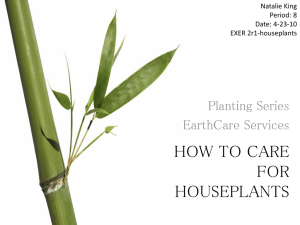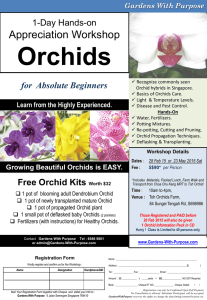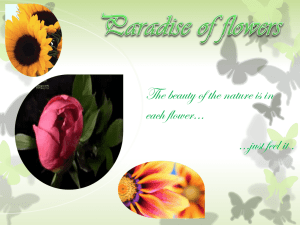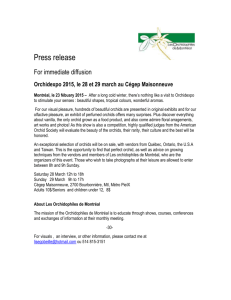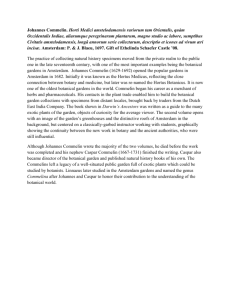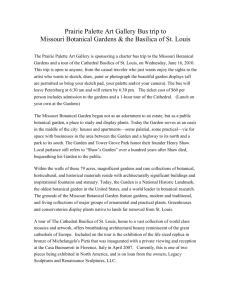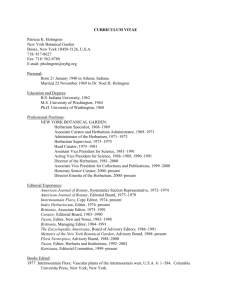It may seems out of scope to present a new system of botanical
advertisement
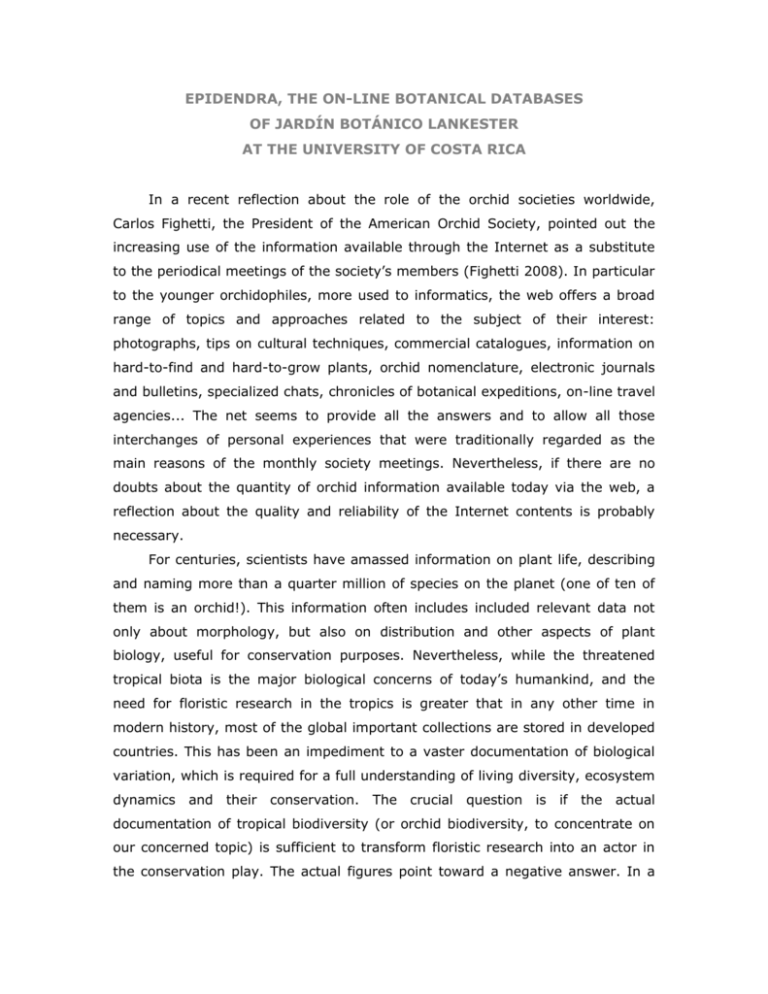
EPIDENDRA, THE ON-LINE BOTANICAL DATABASES OF JARDÍN BOTÁNICO LANKESTER AT THE UNIVERSITY OF COSTA RICA In a recent reflection about the role of the orchid societies worldwide, Carlos Fighetti, the President of the American Orchid Society, pointed out the increasing use of the information available through the Internet as a substitute to the periodical meetings of the society’s members (Fighetti 2008). In particular to the younger orchidophiles, more used to informatics, the web offers a broad range of topics and approaches related to the subject of their interest: photographs, tips on cultural techniques, commercial catalogues, information on hard-to-find and hard-to-grow plants, orchid nomenclature, electronic journals and bulletins, specialized chats, chronicles of botanical expeditions, on-line travel agencies... The net seems to provide all the answers and to allow all those interchanges of personal experiences that were traditionally regarded as the main reasons of the monthly society meetings. Nevertheless, if there are no doubts about the quantity of orchid information available today via the web, a reflection about the quality and reliability of the Internet contents is probably necessary. For centuries, scientists have amassed information on plant life, describing and naming more than a quarter million of species on the planet (one of ten of them is an orchid!). This information often includes included relevant data not only about morphology, but also on distribution and other aspects of plant biology, useful for conservation purposes. Nevertheless, while the threatened tropical biota is the major biological concerns of today’s humankind, and the need for floristic research in the tropics is greater that in any other time in modern history, most of the global important collections are stored in developed countries. This has been an impediment to a vaster documentation of biological variation, which is required for a full understanding of living diversity, ecosystem dynamics and their conservation. The crucial question is if the actual documentation of tropical biodiversity (or orchid biodiversity, to concentrate on our concerned topic) is sufficient to transform floristic research into an actor in the conservation play. The actual figures point toward a negative answer. In a short review of the available records kept in six major herbaria relatively to 350 Costa Rican orchid species, Dressler (1996) found that 78% of the taxa were represented by less than 6 collections. Of those, 20% were based on a single collection, and for 74 species (21%) he cannot find a single herbarium specimen in the herbaria sampled. The obvious incongruity is that we do not know the flora of the tropics enough to really orient conservation policies, mainly if we consider that only at most 15 percent of the life diversity on Earth has been apprehended by science, and new species are turning up constantly from the scattered expeditions to rich tropical areas. An effective electronic information system has been acknowledged in the last thirdy years as an important tool to provide dissemination of the information sources represented by biological collections kept in developed countries, including botanical collections. The access to this information is crucial to all the people involved in one way or the other with orchids: producers, conservationists, collections managers, authorities, judges, growers and, of course, scientists. The possibility to rapidly document the presence of some species in a given area via the access to reliable electronic data may be essential in influencing decision makers at any level, but once more the quality and efficiency of this documentation is directly associated to the amount of the available information. Historically, however, the access to research collections and data resources has been a significant impediment for scientists working in tropical countries, where, paradoxically, a better documentation system is needed for the identification, comparison, and management of the much more diverse floras. Even though botanists have been rather slow in upgrading to the use of electronic databases, it is true today that from the personal computer in his office, in any part of the world, a botanist may instantly link to a number of powerful electronic databases, avoiding the time to correspond and to travel to botanical libraries and herbaria in order to gather the requested information, an activity that only a few decades ago would have taken months. Nevertheless, one common character of the available tools for electronic retrieval of botanical information is that they provide a system of references, which supposes some facility in the direct access to the sources through libraries and herbaria services. This is often not the case in tropical countries, where facilities are insufficient, if not absent, and where the lack of historical libraries and the relatively “modern” herbaria represent a major obstacle for botanic research when concerned with the retrieval of historical information (Pupulin & Warner 2005). Originally born to respond to the information needs of the research staff, the databases system at Lankester Botanical Garden focused since the beginning on the direct availability of the original sources. The system was named EPIDENDRA, the plural of Epidendrum, alluding to the old name under which Linné knew all the epiphytic orchids from the tropics (from the Greek epi, upon, and dendron, tree). As a mainly “internal” tool, EPIDENDRA was designed to gather and make electronically available all the materials from the garden’s collections: the documentation center, the library, the living plant collections and the ancillary collections (spirit, pollinaria, slides, scans, material in silica). Since 2002, researchers of Lankester Botanical Garden began to digitally document type and critical specimens of the Neotropical orchid flora, carrying out a complete survey of Costa Rican and Central American types at the Harvard University Herbaria (Pupulin & Romero 2003). This work was continued in recent years through the acquisition of digital images and hard-to-find literature from the rich orchid herbaria of the Royal Botanic Gardens, Kew (including the Lindley herbarium), the Natural History Museum in Vienna (Reichenbach herbarium), the Royal Botanical Garden of Madrid (Spanish expeditions to the New World), and the Marie Selby Botanical Gardens, one of the richest depositories of Neotropical orchid types. Today, all these materials are available in the Internet also for our colleagues and the general public around the world at EPIDENDRA web page: www.epidendra.org. Updated and critically evaluated taxonomy, taxonomic history, crossreferenced synonymy, PDFs of the original protologues and images of the types, photos to illustrate the range of species’ natural variation, images of pollinaria, historical and modern botanical illustrations and drawings, references to the collections preserved at Lankester Botanical Garden and to gene banks, and downloadable PDFs of the relevant literature, constitute the core of EPIDENDRA. Botanists working in tropical areas have an immense opportunity to improve our knowledge of life diversity and to provide a bridge between systematic research and the general public, incorporating to their source-based systems other data which are not accessible to their colleagues in the first world, and more “emotive” aids like visual databases of specimens, slides, drawings, etc., helping to match the specimen with known taxa. They include field observations on species frequency and natural variation, susceptible habitats, pollination biology, relationships with other organisms, etc. But, foremost, tropical botanists have the still unachieved chance to “portray” biodiversity for the use of the public through in studio work, mainly based on digital imaging. Knowing something always makes it more valuable, and only what it is valued will ultimately be saved. Enjoy the show… LITERATURE CITED Dressler, R.L. 1996. Costa Rica and its orchid diversity. Proc. World Orchid Conf., Rio de Janeiro: 321—331. Fighetti, C. 2008. The changing orchid world. Orchids, Mag. Amer. Orch. Soc. 77(4): 248. Pupulin, F. & G.A. Romero. 2003. Costa Rican Orchidaceae types (Crotypes) digital imaging documentation at AMES, Harvard University. Lankesteriana 3(2): 11—16. Pupulin, F. & J. Warner. 2005. Know your orchids. A botanical garden rich in information serving a country rich in flora. Orch. Res. Newsletter 6: 5—8. FRANCO PUPULIN Lankester Botanical Garden, University of Costa Rica. P.O. Box 302-7050 Cartago, Costa Rica, CA. fpupulin@cariari.ucr.ac.cr
